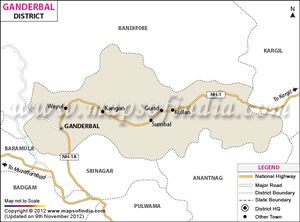Haran Ganderbal
| Author:Laxman Burdak, IFS (R) |

Haran (हरण) is a Village in Ganderbal Block in Ganderbal District of Jammu & Kashmir State, India.
Variants
Location
It is located 1 KM towards East from District head quarters Ganderbal. 17 KM from State capital Srinagar, Jammu. Haran is surrounded by Lar Block towards west , Wakura Block towards west , Kangan Block towards East , Narbal Block towards South . Srinagar , Bandipore , Sopore , Baramula are the near by Cities to Haran. This Place is in the border of the Ganderbal District and Srinagar District. Srinagar District Srinagar is South towards this place . Also it is in the Border of other district Badgam . [1]
Origin
Jat clans
History
City of Harran
The ruins of the city of Harran, called Haran (Hebrew: חָרָן, Ḥārān) in the Hebrew Bible, might lie within present-day Turkey. Haran first appears in the Book of Genesis as the home of Terah and his descendants, and as Abraham's temporary home. Later biblical passages list Haran among some cities and lands subjugated by Assyrian rulers and among Tyre's trading partners.
Haran is usually identified with Harran, now a village of Şanlıurfa, Turkey. Since the 1950s, archeological excavations of Harran have been conducted,[2][3] which have yielded insufficient discoveries about the site's pre-medieval history[4] or of its supposed patriarchal age.[5] The earliest records of Harran come from the Ebla tablets, c. 2300 BC. Harran's name is said to be from Akkadian ḫarrānum (fem.), "road"; ḫarrānātum (pl.).[6]
Wicker willow work
Apart from Haren and Shalabugh, villages like Gadora, Kujur, Kahan, Gogjigund, Fakirgund and Sindbal are involved in the manufacture of willow baskets. The raw material for the willow works is obtained after willow trees are cut in mid Oct-Nov. The trees are then put in a boiler and its skin is peeled off. After this, the peeled skin is put under sunlight for three days when it becomes ready for processing and manufacturing.
Once the products are finished, the people of Shalabugh village sell them in the adjoining village called Haren. “The villagers of Haren have well established market links in the Valley as well as in different states of India. We sell our products to the dealers of the village, who later sell them to the dealers in Kashmir, Delhi or in other states,” said Sonauallah Khandey, one of the oldest craftsmen of willow baskets in Shalabugh.
Khandey says the main beneficiaries of willow trade were those who didn’t know the basics of the craft. “The irony of the trade is that the dealers outside Kashmir call themselves chief craftsmen while we are not even appreciated,” he says. Due to a failure of the villagers to market their products, they are forced to sell them to middlemen. “Somehow we have failed to channelize our products by ourselves, which is the reason behind the meager profits we earn at the end,” he says.
There is another undesirable development taking place with willow craft in Shalabugh. In order to meet the growing requirement of raw material, the villagers are cultivating willow on agricultural lands. The people who hold agricultural land claim the practice of cultivating willow has decreased the yield of agricultural land. “Earlier, willow wasn’t grown on the land meant for agriculture. The large participation of unemployed youth and a sudden growth in demand has triggered this crisis,” says Ghulam Hassan, a farmer. He said there was abundant water lodged land in Shalabugh which could have been used for cultivating willow rather than destroying agricultural land. “But that step requires consent of authorities which the villagers have not sought yet,” Hassan says.
It is not clear how Haren pioneered the craft and how it was later learnt by other villages including Shalabugh. “It is not known how these people learnt this craft. In 1955, willow plantation was started in Haren. It reached our village in 1957,” said Sonauallah Khandey, who was a student of class 3 when the trade began in Shalabugh.
A story doing rounds in the village is that a westerner was impressed with his friend who was a resident of Haren village and, as a token of gift; he planted a willow tree in Haren. “I was witness to that development myself. That Englishman wanted to give renewable source of income to the people of Haren which he gave in the form of willow trees,” Sonauallah says.
Interestingly, Haren had made it mandatory for its villagers that this newly acquired craft shouldn’t be passed on to other adjoining villages. They feared that once it was learnt by others, it will impact their trade. But the plan to shield the trade was dealt a blow by craftsman from Chadoora village. ”Two villagers had decided to set up a cottage factory of willow baskets. They had hired employees from Chadoora who leaked the secrets of the trade to others,” says Sonauallah.
Once the art of the craft was passed on to Shalabugh village, Haren village started providing seeds of willow to the people of Shalabugh to obtain raw materials. “They showed this generous gesture only to meet their growing demands,” says Sonauallah.
Ref - https://kashmirlife.net/willow-village-6412/
References
- ↑ http://www.onefivenine.com/india/villages/Ganderbal/Ganderbal/Haran
- ↑ Lloyd and Brice. Harran, Anatolian Studies, Vol. 1, 1951, p. 77-111
- ↑ Rice, David S. Medieval Harran. Studies on its Topography and Monuments, Anatolian Studies Vol. 2, 1952, p.36–84
- ↑ Bienkowski & Millard. Dictionary of the ancient Near East (ISBN 0812235576, ISBN 978-0-8122-3557-9), 2000, p.140
- ↑ Alexander & Baker. Dictionary of the Old Testament: Pentateuch, (ISBN 0830817816, ISBN 978-0-8308-1781-8) 2003, p. 379
- ↑ Huehnergard, John. A Grammar of Akkadian (Second Edition, 2008), p. 36, p. 497